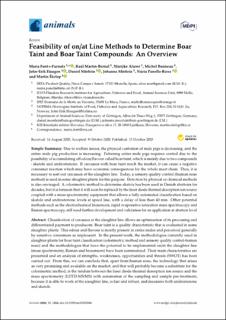Feasibility of on/at Line Methods to Determine Boar Taint and Boar Taint Compounds: An Overview
| dc.contributor.author | Font-i-Furnols, Maria | |
| dc.contributor.author | Martin-Bernal, Raul | |
| dc.contributor.author | Aluvé, Marijke | |
| dc.contributor.author | Bonneau, Michel | |
| dc.contributor.author | Haugen, John-Erik | |
| dc.contributor.author | Mörlein, Daniel | |
| dc.contributor.author | Mörlein, Johanna | |
| dc.contributor.author | Panella-Riera, Nuria | |
| dc.contributor.author | Škrlep, Martin | |
| dc.date.accessioned | 2020-11-13T10:29:44Z | |
| dc.date.available | 2020-11-13T10:29:44Z | |
| dc.date.created | 2020-10-22T10:58:16Z | |
| dc.date.issued | 2020 | |
| dc.identifier.issn | 2076-2615 | |
| dc.identifier.uri | https://hdl.handle.net/11250/2687767 | |
| dc.description.abstract | Classification of carcasses at the slaughter line allows an optimisation of its processing and differentiated payment to producers. Boar taint is a quality characteristic that is evaluated in some slaughter plants. This odour and flavour is mostly present in entire males and perceived generally by sensitive consumers as unpleasant. In the present work, the methodologies currently used in slaughter plants for boar taint classification (colorimetric method and sensory quality control-human nose) and the methodologies that have the potential to be implemented on/at the slaughter line (mass spectrometry, Raman and biosensors) have been summarized. Their main characteristics are presented and an analysis of strengths, weaknesses, opportunities and threats (SWOT) has been carried out. From this, we can conclude that, apart from human nose, the technology that arises as very promising and available on the market, and that will probably become a substitute for the colorimetric method, is the tandem between the laser diode thermal desorption ion source and the mass spectrometry (LDTD-MS/MS) with automation of the sampling and sample pre-treatment, because it is able to work at the slaughter line, is fast and robust, and measures both androstenone and skatole. | |
| dc.language.iso | eng | |
| dc.subject | LDTD MS MS | |
| dc.subject | LDTD MS MS | |
| dc.subject | Boar taint | |
| dc.subject | Boar taint | |
| dc.subject | REIMS | |
| dc.subject | REIMS | |
| dc.subject | Human nose | |
| dc.subject | Human nose | |
| dc.title | Feasibility of on/at Line Methods to Determine Boar Taint and Boar Taint Compounds: An Overview | |
| dc.type | Peer reviewed | |
| dc.type | Journal article | |
| dc.description.version | publishedVersion | |
| dc.source.volume | 10 | |
| dc.source.journal | Animals | |
| dc.identifier.doi | 10.3390/ani10101886 | |
| dc.identifier.cristin | 1841402 | |
| dc.relation.project | COST (European Cooperation in Science and Technology): 15215 | |
| cristin.ispublished | true | |
| cristin.fulltext | original | |
| cristin.qualitycode | 1 |
Tilhørende fil(er)
Denne innførselen finnes i følgende samling(er)
-
Artikler / Articles [1456]
-
Publikasjoner fra CRIStin [2533]
